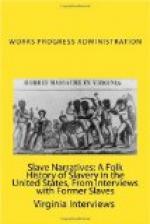“I furnished the horses for the hearse, and one night I tole the boys to leave it in the stable because we were going to have another funeral the next day.
“Each night one of the boys had to sleep in the office, and this particular night it was Bill’s turn. Bill was an old, one-legged negro and very superstitious. He said:
“Boss, this is my night to stay here, and you know, boss, I sho likes to work for you, but I jest tells you now there jest hain’t room in this here house fer me and that black wagon at night.” I moved the hearse.”
Some slaves were owned in Knox Co., most of them being in Barbourville where they served as house-servants. The negro men worked around the house and garden, while the women were cooks and maids. The slaves usually lived in small one-room houses at the rear of their masters home, and were generally well fed and clothed.
There was some trading of slaves among the Barbourville and Knox County owners, and few were sold at Public Auction. These public sales were held on Courthouse Square, and some few slaves were bought and sold by “Negro Traders” who made a business of the traffic in blacks. Occasionally a negro man would be sold away from his family and sent away, never to see his people again.
Most Kentucky superstitions are common to all classes of people because the negroes originally obtained most of their superstitions from the white and because the superstitions of most part of Kentucky are in almost all cases not recent invention but old survivals from a time when they were generally accepted by all germanic peoples and by all Indo-Europeans.
The only class of original contributions made by the negroes to our stock of superstitions is that of the hoodoo or voodoo signs which are brought from Africa by the ancestors of the present colored people of America. On the arrival of the negro in America, his child like mind was readily receptive to the white man’s superstitions.
The Black slave and servants in Kentucky and elsewhere in the South have frequently been the agents through which the minds of white children have been sown with these supernatural beliefs, some of which have remained permanently with them. Nearly all classes of superstitions find acceptance among the negroes. The most widely prevalent are beliefs concerning haunted houses, weather signs, bad luck and good luck signs, charm curse and cures and hoodoo signs. Their beliefs that the date of the planting of vegetables should be determined by the phases of the moon is unshaken.




